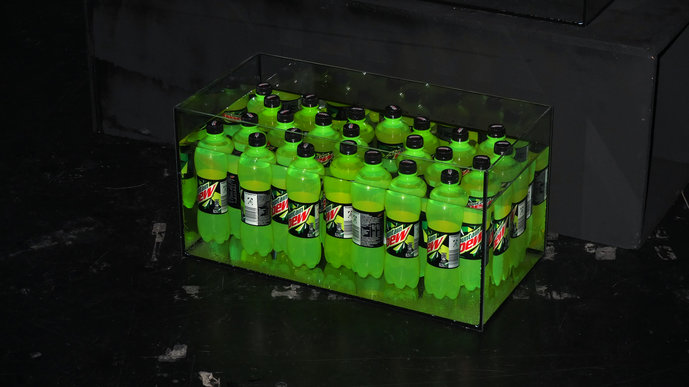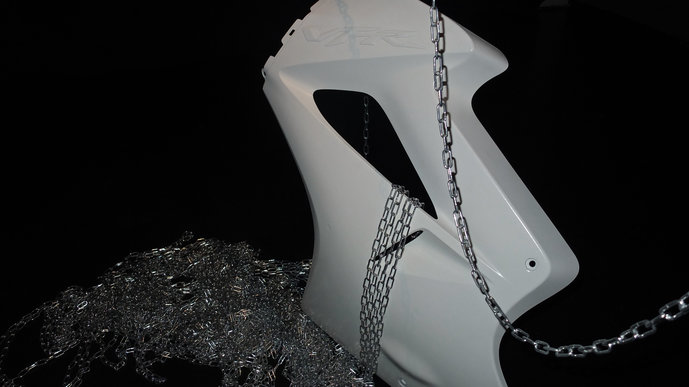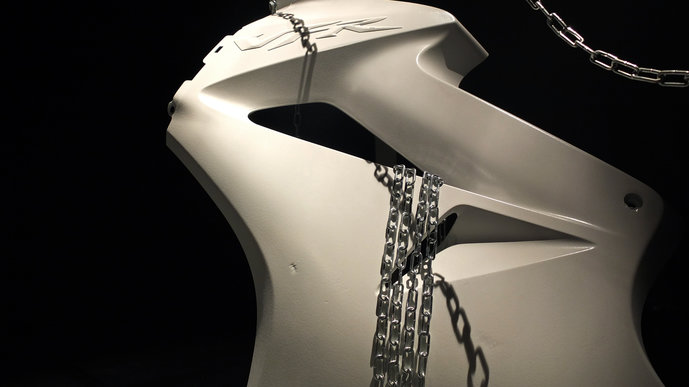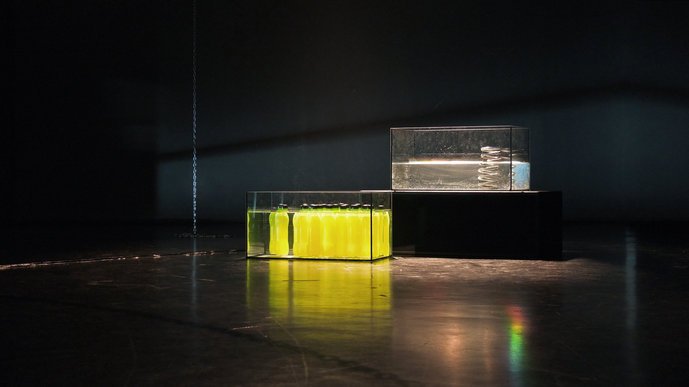

© Manuel Sékou


© Manuel Sékou


© Manuel Sékou


© Manuel Sékou


© Manuel Sékou


© Manuel Sékou
Deeeep-aperitif-thoughts:
luxxuryproblems_
hybridization would be the most (un)natural thing you could do<<
The work hybridization would be the most (un)natural thing you could do reflects on a multidimensional atmosphere of mutated materiality, concerning the temporality on a line between the very present moment and its following instants, ranging from the immediate future to a further, imagined future-ambiance. This (non-)matter derives from an interconnection of abstract content (sound, light) together with solid objects such as steel chains, hoardings, liquids, and a motorbike chassis. Their common ground is the occupation, division and definition of space.
The transition between the particular elements that constitute this room-installation is in their individual grade of endorsement of movement. As in the common nature of living organisms, it is about the question of movement, evolution, processing, formation, development, thus about the ability of preserving these activities.
Within a paradoxical affair, these two tendencies are continuously influenced by environmental, ecological, social, economical, political, physical, psychical... modes of movement, which cause situations ranging from complete slack to (extreme) acceleration. Thereby evolved conflicts are increasingly vanishing into streams of digital/virtual flows, that become visual on the screens of smart devices. This drift of dis-embodiment affects behavioral standards and codes for which reason any further development also changes how especially human beings act, perceive and sense the world. Begging the question for a permanent metamorphosis (or mutation?), the sound piece’s different chapters fluently merge into each other, bending itself from ambient parts over ASMR interludes to beat-driven patterns, being able to extend its boundaries unlike material objects that are rather enclosed in their inertial shell, haptic and visible on their surface. The sound aims to blend and express feelings of comfortable (tech)-ambiance to alienated artificiality.
The opulence of the sound texture addresses the potential maximalism with whom a persona is confronted concerning the manifold sources of input, information and communication that is circulating in between different (sub-)cultures, or (micro-) milieus as a multitude of referential layers: As a contemplative gedankenexperiment to unchain oneself by engaging with the hyperlinked cosmos, to trans-mutate into a post-everything sphere of existence. Apart from that, the sound arrangement shows its versatility and ambiguity by not being as bodied as physical matter, and therefore its capacity of intuitive expression (a glimpse of transient veracity).
The extramusical components appear as shadows and gleams of technical objects, that suggest the human body to interact with or within them, rather like a machine than a man. Thus the human body (at that particular moment only visible as shadows by dynamic reflection of the recipient) becomes a kind of hybrid corpus by interacting and extending itself with its anthropogenically developed add-ons. To continue this thought, these externals evolve into plug-ins: a constituted mixture of two different species.
The provided tech environment is an exercise in aesthetics of the idea of a hybrid organism, inspired by the movements and codes of the internet and online culture based on referential patterns, especially with appropriative tendencies and re-contextualization of elements of design or history. The artifacts, detached from their original context of utility, thereby obtain a quality of action as a cluster of (blurry) memories of the past, the present and the future: As a cultural technique to communicate and express ideas by using imagery as a vague but intimate code/language. The room as such can be experienced as an informed locality by spatialized, imaginary layers of thoughts.
The work embeds the approach of an archaic realism and somehow primitive touch, instead of trying to be futuristic and “sci-fi” by advanced virtual simulation, to achieve loose links between the present everyday life, and posing the question if the now is just an (beautiful, lustrous, ugly, boring, unspectacular?) alternate form of a former sci-fi utopia that is not considered as such, or if the human mind/body has just adopted to the circumstances. This implies the idea of a general mutational aspect in the chain of evolution, which seems to be countered all over the planet in questions of the political, racial, sociological or the environmental. Therefore the metallic shimmer resembles instruments of both guidance, security, integration as well as segregation, exclusion, uncertainty and contourisation of movements.
Tutors:
Rebecca Stephany and Joao Tabarra
[sound/space installation, mixed media, stereo (2 x 2 Channels), 28 min, 2017.]